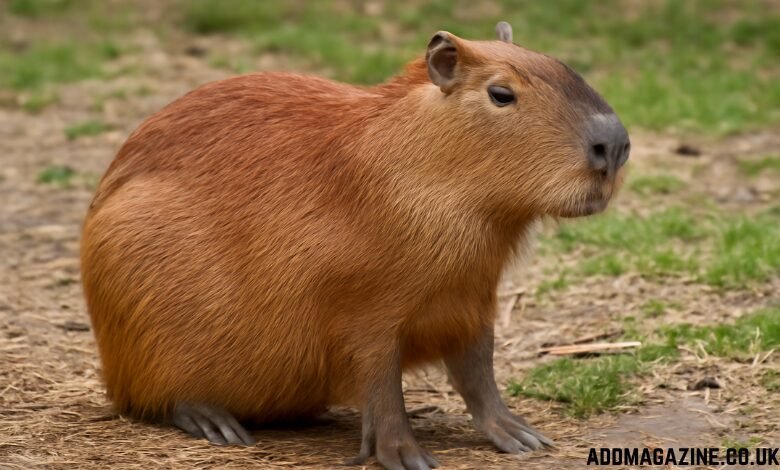Capybaras (Hydrochoerus hydrochaeris) are fascinating creatures, often regarded as the gentle giants of the animal kingdom. As the largest rodents in the world, these social animals have a unique place in the animal world. Native to South America, capybaras have captured the hearts of animal lovers and researchers alike due to their calm demeanor, social structure, and adaptability to various environments. In this blog post, we will explore the capybara’s physical characteristics, behavior, diet, natural habitat, and its relationship with humans and other animals.
Physical Characteristics
Capybaras are instantly recognizable by their large, barrel-shaped bodies and distinctively short, coarse fur. Adult capybaras typically weigh between 35 to 66 kilograms (77 to 146 pounds) and grow to around 1.2 meters (4 feet) in length, not including the tail, which is nearly absent. Their height at the shoulder is about 0.6 meters (2 feet).
Their fur is usually a brownish or reddish-brown color on the upper side and lighter underneath, providing camouflage in their natural environment. Despite their large size, capybaras are surprisingly agile in water, aided by their webbed feet. This ability allows them to swim and dive effectively, making water an essential part of their lifestyle.
Habitat and Distribution
Capybaras are primarily found in the wild in South America, ranging from Venezuela and Colombia in the north to Argentina and Uruguay in the south. Their habitats include savannas, wetlands, and tropical forests, with a strong preference for areas near rivers, lakes, and marshes. They thrive in warm, lowland areas, where there is abundant water for swimming, cooling off, and foraging.
Water bodies play a vital role in the capybara’s daily life. These semi-aquatic creatures are highly adapted for life near water, using it as a refuge from predators, a space for socializing, and a place to forage for aquatic plants. They also have the ability to submerge themselves underwater for up to five minutes to avoid danger.
Diet and Feeding Habits
Capybaras are plant-eaters, primarily feeding on grasses, aquatic vegetation, and various fruits. They are considered grazers and typically feed in the early morning or late evening to avoid the hottest parts of the day. As a result of their herbivorous diet, capybaras spend a large portion of their day foraging for food. Their digestive system is specially adapted to break down the tough plant material in their diet, and they practice coprophagy, meaning they eat their own feces to extract the maximum amount of nutrients.
In the wild, capybaras feed on grasses, fruits, and some woody plants, but their favorite foods are typically the tender young grasses and aquatic vegetation found near rivers or lakes. This diet ensures that capybaras can maintain their large size, providing them with the necessary nutrients and energy.
Behavior and Social Structure
Capybaras are extremely social creatures and are known for their strong family bonds. They typically live in groups ranging from 10 to 20 individuals, although larger groups of up to 100 individuals have been observed in some areas. These groups typically include one dominant male, multiple females, and their young.
The social structure of capybara groups is highly organized. The dominant male leads the group and is responsible for defending the territory, while females and younger capybaras play supportive roles. Each group has its own territory, which they mark using scent glands located near their eyes. Communication among capybaras is frequent and diverse, including vocalizations such as barks, whistles, and purrs, as well as body language, such as grooming and nuzzling each other.
These creatures are also known for their harmonious relationships with other species. In their natural habitat, they often interact peacefully with birds, monkeys, and even smaller mammals. Capybaras are frequently seen hosting a variety of animals on their backs, including birds like the cattle egret, which eats insects that rest on the capybara’s fur.
Reproduction and Lifespan
Capybaras breed year-round, with females giving birth to a litter of 2 to 8 babies after a gestation period of approximately 150 days. Newborn capybaras are fully furred, have their eyes open, and can walk and swim shortly after birth. They remain close to their mothers for protection and nourishment but are quickly integrated into the group’s social structure.
The lifespan of a capybara in the wild typically ranges from 6 to 12 years, though some individuals in captivity have been known to live longer due to better protection and care. In the wild, their life expectancy is impacted by predation, habitat destruction, and environmental changes.
Predators and Threats
While capybaras are relatively large and have few natural predators, they are not without threats. Jaguars, caimans, anacondas, and large birds of prey, such as eagles, are known to hunt capybaras. Despite their size and social structure, capybaras are vulnerable to these predators, especially when they are separated from the group or if they are younger and less experienced.
Humans also pose a significant threat to capybaras through hunting and habitat destruction. In some regions, capybaras are hunted for their meat and hides, while deforestation and agricultural expansion contribute to the loss of their natural habitats. In addition, the introduction of invasive species can further impact capybara populations by disrupting their ecosystems and competing for resources.
Capybaras and Humans: A Unique Relationship
Capybaras have become a source of fascination and affection for many people around the world. In some areas, they are kept as pets, although this is controversial due to their large size and social needs. Capybaras are best suited for life in the wild or in large, social environments where they can interact with other capybaras.
In Japan, capybaras are a popular attraction at zoos and animal parks, and the animals are often seen soaking in hot springs, a practice that has garnered significant attention from visitors. The capybara’s calm demeanor and social nature have made it a favorite among animal lovers, contributing to its growing popularity in both private and public settings.
In South America, capybaras play a role in local culture and are sometimes featured in folklore and traditions. Their gentle behavior and distinctive appearance have made them an emblem of nature and wildlife preservation in many regions.
Conservation Status
The International Union for Conservation of Nature (IUCN) has categorized capybaras as “Least Concern” in terms of conservation status. While their populations are stable in many areas, they face ongoing challenges due to habitat loss and human activities. The preservation of wetlands, rivers, and forests is critical for the survival of capybaras in the wild. Conservation efforts focused on preserving their natural habitat and regulating hunting can help ensure that capybaras continue to thrive in the wild for generations to come.
Conclusion
Capybaras are extraordinary animals that deserve more recognition for their role in maintaining the health of ecosystems in South America. These gentle giants are an essential part of the wetlands and river ecosystems, where they help maintain balance through their grazing habits. While they are not considered endangered at this time, continued efforts to protect their habitats and ensure their populations remain stable are vital.
Whether in the wild or in a zoo, capybaras are endearing and remarkable creatures that highlight the importance of preserving biodiversity and respecting the delicate balance of nature. Understanding the life and habits of capybaras can also inspire a deeper appreciation for wildlife conservation and the need to protect our planet’s diverse ecosystems.




